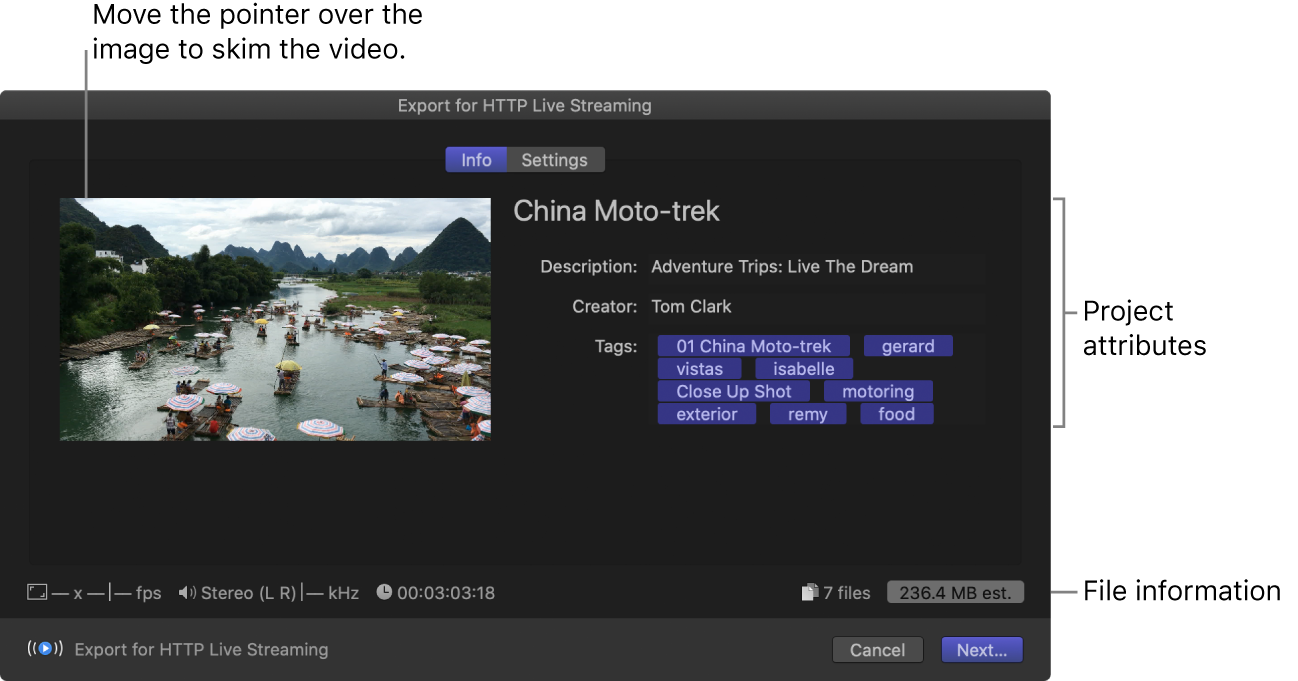Final Cut Pro X User Guide
- Welcome
-
- What’s new in Final Cut Pro 10.4.7
- What’s new in Final Cut Pro 10.4.6
- What’s new in Final Cut Pro 10.4.4
- What’s new in Final Cut Pro 10.4.1
- What’s new in Final Cut Pro 10.4
- What’s new in Final Cut Pro 10.3
- What’s new in Final Cut Pro 10.2
- What’s new in Final Cut Pro 10.1.2
- What’s new in Final Cut Pro 10.1
- What’s new in Final Cut Pro 10.0.6
- What’s new in Final Cut Pro 10.0.3
- What’s new in Final Cut Pro 10.0.1
-
- Intro to effects
-
- Intro to transitions
- How transitions are created
- Set the default transition
- Add transitions
- Delete transitions
- Adjust transitions in the timeline
- Adjust transitions in the inspector and viewer
- Merge jump cuts with the Flow transition
- Adjust transitions with multiple images
- Modify transitions in Motion
-
- Add storylines
- Use the precision editor
- Conform frame sizes and rates
- Use XML to transfer projects
-
- Glossary
- Copyright

Export live-streaming files with Final Cut Pro
If you want to post a movie on a streaming website, you can export an HTTP live-streaming playlist that’s linked to a group of movie segments (such as MPEG-4 files) compressed using different settings. When hosted using the related server software, the playlist dynamically chooses the best version for a user’s device and internet connection speed.
In Final Cut Pro, do one of the following:
Select one or more projects or clips in the browser.
Note: You can’t mix projects and clips in a batch share. Your selection must contain only projects or only clips. See Batch sharing in Final Cut Pro.
Select ranges in one or more clips in the browser.
Select a range in a project in the timeline.
Note: To share just a portion of a project, you must make a range selection. A clip selection is not sufficient. You can use the I and O keys to set the range start and end points.
If you’re sharing a project that is set to use proxy media for playback, open it in the timeline, then click the View pop-up menu in the top-right corner of the viewer and choose Optimized/Original.
This ensures the highest quality in the exported file. When you choose this setting, Final Cut Pro uses optimized media to create the shared file. If optimized media doesn’t exist, the original media is used. For more information about optimized and proxy media, see Control playback quality in Final Cut Pro.
Do one of the following:
Choose File > Share > Export for HTTP Live Streaming.
Click the Share button in the toolbar, then click Export for HTTP Live Streaming.

Important: The HTTP Live Streaming destination doesn’t appear by default. To add it to your set of destinations and to the Share menu, choose File > Share > Add Destination, then double-click the HTTP Live Streaming destination. See Create share destinations in Final Cut Pro and Intro to Destinations preferences in Final Cut Pro.
In the Share window that appears, do any of the following:

Move the pointer over the image to skim the video.
If you’re batch sharing (exporting multiple items), the image is replaced by a list of the items you’re exporting.
In the Info pane, view and modify project or clip attributes, such as the title and description.
See Change metadata for shared items in Final Cut Pro. All of the attributes associated with the project or clip are included in the output file.
Important: By default, the title field lists the project or clip name. Changing the title does not change the project or clip name, which is the name used for the exported file.
At the bottom of the window, view information about the files that will be exported, such as frame size and frame rate, audio channels and sample rate, duration, output file type, and file size.
Click Settings.
Select a file type for the exported file (MPEG-2 Transport Streams or Fragmented MP4).
Select one or more network types on which the movie will be streamed (Cellular, Wi-Fi, or Broadband).
If you added captions to your project, optionally click the “Burn in captions” pop-up menu and choose a language version.
Burned-in captions are permanently visible in the output file and are not the same as embedded captions.
Click Next.
If you selected a single project, clip, or range, enter a name for the file you’re sharing.
Choose a location for the exported files, then click Save.
Your selection is transcoded, and the exported segments are saved in folders. An index.html file and a readme.html file containing information on how to post your project to your website are included in the export. See your server administrator.
You can monitor the progress of the transcode in the Background Tasks window, and you can continue to work in Final Cut Pro while the file is transcoded.
When transcoding is complete, a notification appears. You can view and locate shared projects in the Share inspector. See View the status of shared items in Final Cut Pro.